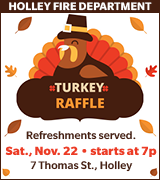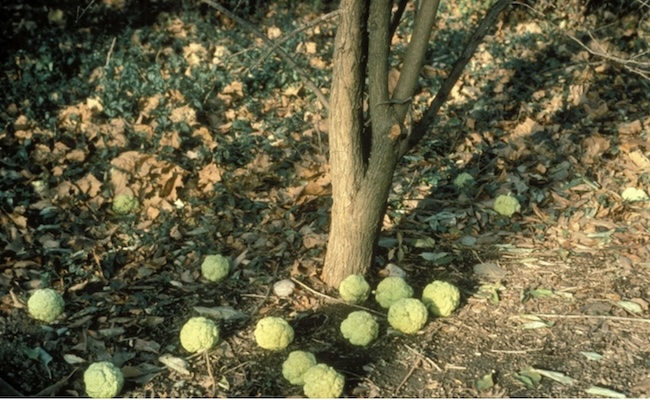Before barbed wire, Osage orange trees were popular as impenetrable hedges
By Catherine Cooper, Orleans County Historian
“Illuminating Orleans” – Volume 4, Number 36

They are about the size of a tennis ball, but heavier, with a wrinkled surface and a delicate lemony scent. These are the seeds of the female Osage orange tree.
Scientists hypothesize that the Osage orange dates to the Pleistocene era when it was eaten by mastodons and other large herbivores. The tree’s name designation derives from the slightly orange color of the wood and from the geographic area where it originated – that area of the southern Plains that is home to the Osage Indians. Its scientific name is Maclura Pomifera, it is also referred to as a Hedge Apple or Horse-Apple tree.
Osage orange wood is very strong. It was favored by American Indians for making bows and by settlers for making wagon wheels. But it was the short, sharp thorns that grow on the lower limbs that made the tree very popular with farmers. Planted close together in a row, the trees grow quickly and straight and soon form a prickly, impenetrable hedge.
A search of the Orleans County newspapers shows that Osage orange trees were being sold and recommended for fencing as early as 1854 and regularly thereafter.
- April 1869, Randall King, of Kendall Corners, advertised 50-60 thousand “good strong plants of my own raising.” (Orleans Republican)
- April 1878, W.S. Webb of North Ridgeway, advertised 10,000 two-year-old Osage Orange hedge plants for sale at $2.25 per thousand. (Medina Tribune)
- March 1880, A.G. Barlow & Co. of North Ridgeway, advertised 40,000 plants for sale at $2.25 per thousand. (Medina Tribune)
- April 1881, S.C. Wood, Long Bridge Nursery, Knowlesville, sold the tree along with a wide variety of fruit and ornamental trees. (Medina Tribune)
Barbed wire gradually replaced Osage orange trees for fencing, the hard wood was then used to make fence posts. The trees were not mentioned again in the Orleans County newspapers for many years, until 1971 when an article in the Medina Daily Journal announced that the NYS Dept. of Environmental Conservation was offering landowners 250 seedlings of a variety of hardwood trees, including the Osage orange, on a first-come, first-served basis and “upon approval by a State Forester” for reforestation purposes.
Osage orange trees may be either male or female, both are required for fruiting, but only the female tree produces fruit which contains seeds encased in a fleshy pulp, with a sticky white sap in the center. The seeds are exposed as the outer layer disintegrates. The trees may be cultivated from seed – several Osage orange enthusiasts have shared their “how to” expertise on YouTube videos.
Some people place the fruit in corners and basements as they are believed to repel spiders while others use them for decorative purposes. In either case, it is interesting to consider the long links of this tree back to prehistoric times.





































































